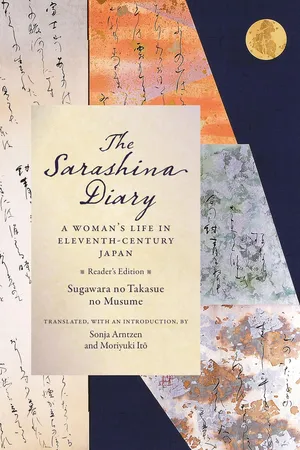
The Sarashina Diary
A Woman's Life in Eleventh-Century Japan (Reader's Edition)
- English
- ePUB (mobile friendly)
- Available on iOS & Android
The Sarashina Diary
A Woman's Life in Eleventh-Century Japan (Reader's Edition)
About this book
A thousand years ago, a young Japanese girl embarked on a journey from deep in the countryside of eastern Japan to the capital. Forty years later, with the long account of that journey as a foundation, the mature woman skillfully created an autobiography that incorporates many moments of heightened awareness from her long life. Married at age thirty-three, she identified herself as a reader and writer more than as a wife and mother; enthralled by fiction, she bore witness to the dangers of romantic fantasy as well as the enduring consolation of self-expression.
This reader's edition streamlines Sonja Arntzen and Moriyuki It?'s acclaimed translation of the Sarashina Diary for general readers and classroom use. This translation captures the lyrical richness of the original text while revealing its subtle structure and ironic meaning, highlighting the author's deep concern for Buddhist belief and practice and the juxtaposition of poetic passages and narrative prose. The translators' commentary offers insight into the author's family and world, as well as the style, structure, and textual history of her work.
Frequently asked questions
- Essential is ideal for learners and professionals who enjoy exploring a wide range of subjects. Access the Essential Library with 800,000+ trusted titles and best-sellers across business, personal growth, and the humanities. Includes unlimited reading time and Standard Read Aloud voice.
- Complete: Perfect for advanced learners and researchers needing full, unrestricted access. Unlock 1.4M+ books across hundreds of subjects, including academic and specialized titles. The Complete Plan also includes advanced features like Premium Read Aloud and Research Assistant.
Please note we cannot support devices running on iOS 13 and Android 7 or earlier. Learn more about using the app.
Information





Atsumi Mountain | location uncertain |
Awazu | area of Ōtsu City |
C... |
Table of contents
- Cover
- Series Statement
- Title Page
- Copyright
- Contents
- Preface to the Reader’s Edition
- Introduction
- Sarashina Diary
- Appendix 1. Family and Social Connections
- Appendix 2. Maps
- Appendix 3. List of Place Names Mentioned in the Sarashina Diary
- Notes
- Bibliography
- Index
- Series List